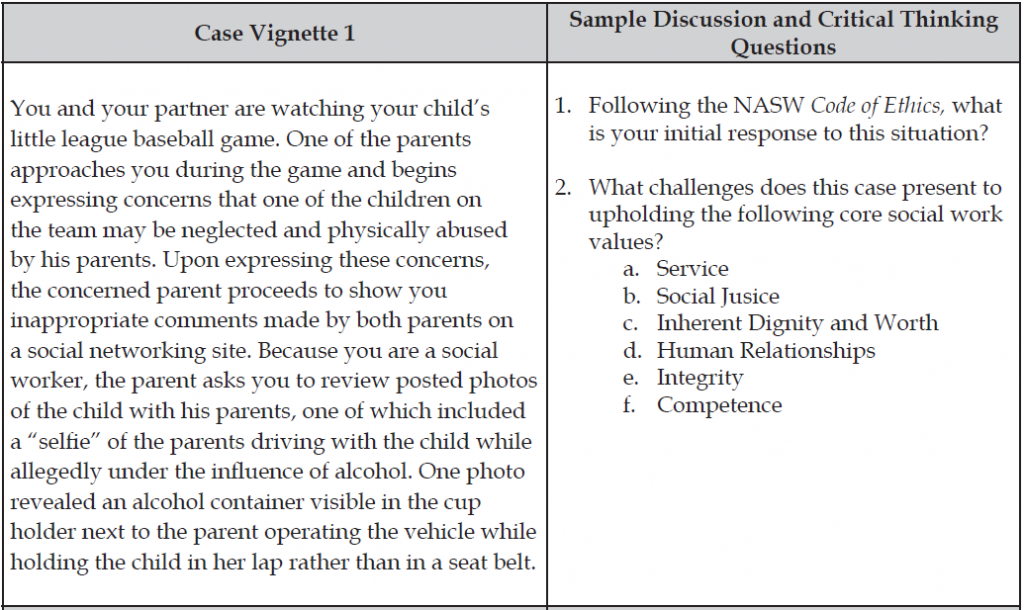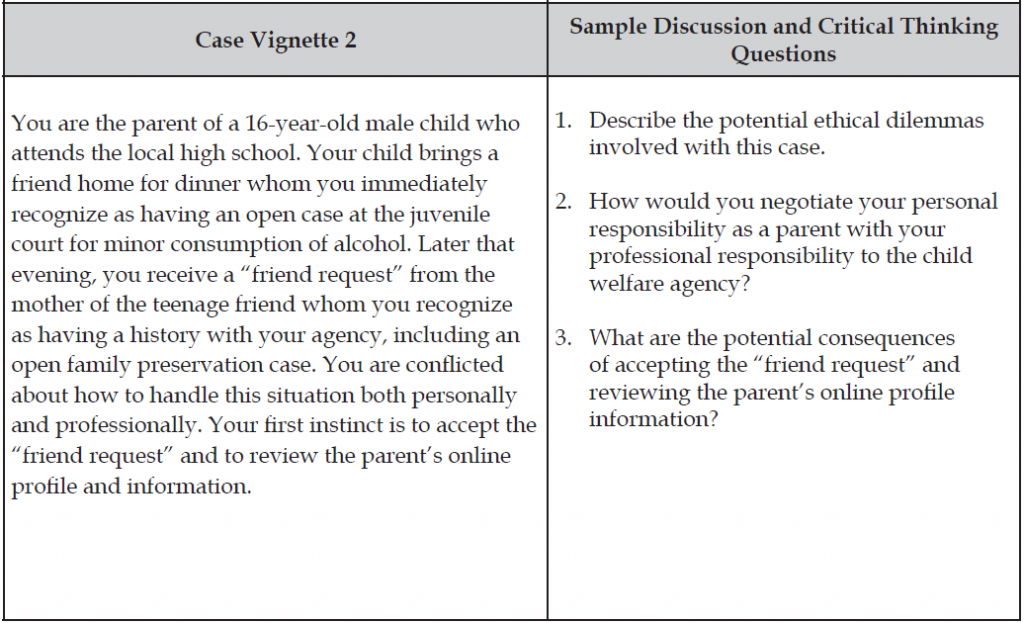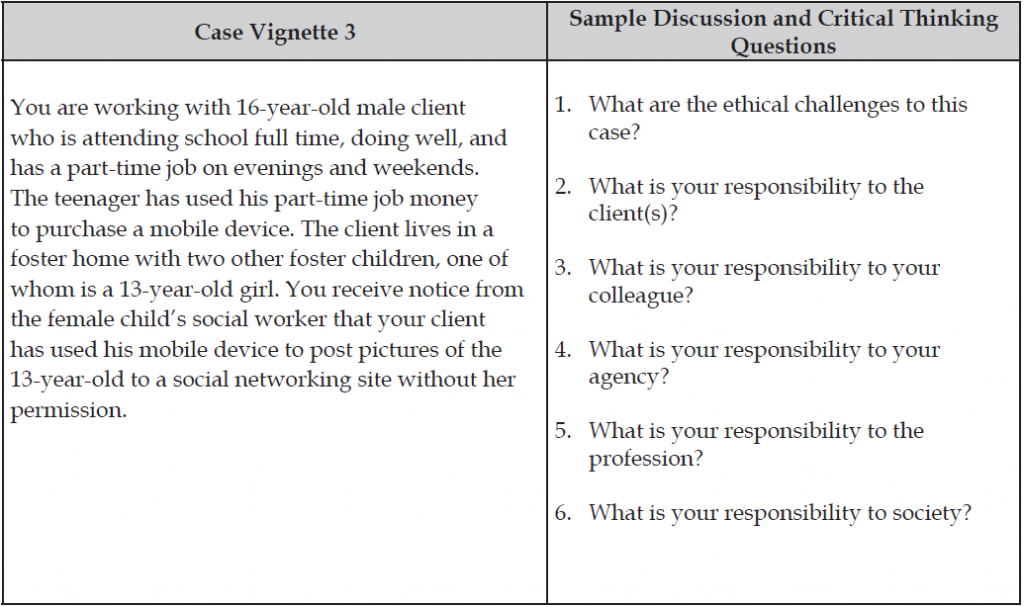Introduction
The connection between our profession and the protection of children from harm is historic and represents the heart of social work as a discipline (Zlotnik, 2008). Social workers in child welfare practice pursue the essential charge of protecting children from acts of physical abuse, sexual abuse, emotional abuse, and the various forms of neglect including (but not limited to) medical neglect, truancy, and inattention to physical and developmental needs (Hamilton & Bundy-Fazioli, 2013; Shireman, 2015). In the academy of social work education, student placements in public child welfare agencies are often considered among the most challenging, while at the same time mainstays for many field education programs. While the Council on Social Work Education (CSWE) specifies that social work students must demonstrate competence with regard to ethical and professional behavior (CSWE, 2015), this generalist standard does not address ethical challenges and dilemmas that are unique to the practice of child welfare. Hence, common ethical dilemmas in child welfare practice, such as negotiating the practice obligation to keep families together while also keeping children safe, may prove challenging for field education students contemplating a career in public child welfare (Shireman, 2015).
University/Agency Partnerships
One approach to providing child welfare–specific content to students completing field placements in public child welfare agencies is to facilitate Title IV-E university/agency partnerships. Title IV-E partnerships between public child welfare agencies and universities have been in existence for half a century, and have great potential to enhance both the education and recruitment of prospective child welfare professionals at the BSW and MSW levels of practice (Anderson & Briar-Lawson, 2015: O’Donnell & Kirkner, 2009; Zlotnik, 2008). As a component of the Social Security Act, Title IV-E provides federal funding to facilitate programming for children in the child welfare system of care. Title IV-E funds are designated for state foster care programs, transitional independent living programs, guardianship assistance, and adoption assistance. Further, in pursuit of a highly skilled child welfare workforce, allocations from Title IV-E provide states with funding earmarked for the education and training of both current and future child welfare professionals (Greeno, et. al, 2017; Zlotnik, 2008).
Two primary components of Title IV-E agency/university partnerships are the placement of students into public child welfare agencies as their capstone field education experience and the provision of professional development, continuing education, and training opportunities to current child welfare workers. Thus, students completing field placements in child welfare agencies have the opportunity to enhance their knowledge of child welfare practice by participating in university/agency training opportunities. Moreover, through training partnerships, faculty have the opportunity to strengthen relationships with child welfare agencies by facilitating professional development and continuing education opportunities for current and future child welfare professionals.
This paper outlines one statewide Title IV-E training initiative designed to enhance the practice knowledge and skills of public child welfare workers on engaging ethical dilemmas. The training was conducted as part of a six-hour continuing education workshop on professional ethics in public child welfare practice consisting of three specific training modules on social work values and ethics, ethical dilemmas, and interactive case illustrations. Two university faculty members, who also serve on the state’s higher education consortium on child welfare, facilitated the training. The Title IV-E–funded training sessions had three major objectives. First, the trainers sought to educate child welfare workers on the integration of professional ethics and the core values of the social work profession as they relate to contemporary practice with children and families. Building on the first training objective, the subsequent modules aimed to increase the pragmatic use of social work ethics when confronted with ethical dilemmas in professional practice (training objective two) and to inform participants on the complex intersection of morals, ethics, and professional values as they relate to ethical dilemmas (training objective three). As part of the training sessions, three child welfare–specific case vignettes were used as training exercises to illustrate the didactic material while also engaging meaningful dialogue among the workshop participants. As part of the educational efforts to better prepare field education students for successful placements in public child welfare agencies, social work faculty may utilize the training modules, case vignettes, and discussion questions (as outlined in this paper).
Training Participants
The Title IV-E workshop participants included 172 direct practitioners in several child welfare divisions within one southern state. The participants included child welfare professionals serving in the roles of child abuse and neglect investigators, forensic interviewers, family preservation specialists, foster care and adoption workers, resource development specialists, and child welfare service supervisors. The training opportunity was made available to all child welfare workers and child welfare supervisors serving in direct practice roles with consumers of public child welfare services. The training was completed at six different training sites located in one southern state.
Module 1: Ethics and Child Welfare Practice
The first didactic component of the training began with an introduction to the philosophy of ethics as it applies to the professional development of social workers and to child welfare practice. Social work is a “value-based” profession, a label that suggests the existence of formally developed and articulated ethical codes that guide practice. The standards for professional behavior outlined in the NASW Code of Ethics are driven by a core set of beliefs (or values) that are reflective of the spirit of the social work profession (Barsky, 2010; Chechak, 2015; Frunza & Sandu, 2017). The social work Code of Ethics is rooted in the unique values of the social work profession, which include the deep commitment to serving those who are in need, practice pursuant to issues of social justice, the value of all human beings, the importance of human relationships, and the ongoing commitment to professional integrity and competence (NASW, 2017; Reamer, 2009). Both values and ethics are influenced by an interpersonal and societal sense of what is right, wrong, and fair to members of our society (Banks, 2010; Dolgoff et al., 2012). Therefore, as a function of the spirit, mission, and values of the social work profession, child welfare workers provide an essential and valuable service to vulnerable children and their families. Based on these principles, child welfare work not only involves an ethical obligation to children and their families, but also to colleagues, to their child welfare agencies, to the community, and ultimately to the profession of social work itself (Reamer, 2009).
Module 2: Ethical Dilemmas in Child Welfare Practice
The second training module integrated the philosophy of social work ethics in child welfare practice with the practice of resolving ethical dilemmas. Ethical dilemmas arise when child welfare workers are forced to make difficult practice decisions on behalf of the children and families they serve where one or more consequential options are present. Resolving ethical dilemmas can be a difficult process for child welfare workers, particularly when the resolution involves conflicting opinions between clients, the agency, colleagues, and the community (Osmo & Landau, 2006; Reamer, 2015). At deeper and more interpersonal levels, ethical dilemmas often require social workers to negotiate the complex intersections between their own professional, moral, and spiritual value systems in an effort to do what is right for the family while also following policy (Adams, 2009; Gray, 2009; Pullen-Sansfacon, 2010). For example, the competing role demands to both safeguard children and maintain intact families can cause significant role strain upon social workers. Role strain, or the felt difficulty in carrying out obligations to two competing demands associated with one status, is an inherent problem in the social structure of child protective services. Furthermore, the consequences of these decisions can be life altering to the children and families involved. This contributes significantly to the difficulty of carrying out the functions of these child welfare positions.
Case Vignettes as Tools for Training and Education
As a method of providing situational context to the training modules, the participants were provided with three short case vignettes involving child welfare work and ethical dilemmas. Case vignettes are useful as elicitation tools and for response-probing from research participants, particularly with sensitive topical areas, such as issues of moral or ethical judgment (Barter & Renold, 1999; Finch, 1987; Hughes & Huby, 2004; Taylor, 2006; Wilks, 2004). While there are few set standards by which a case vignette should be constructed, it has been suggested that for a case study to be useful in capturing the complexity a particular social problem, the vignette should be as realistic and relevant as possible to the target problem and to the lives of the research participants (Hughes & Huby, 2004; Wilks, 2004). In adherence to these basic principles, the following three case vignettes were developed using multiple sources including the personal and professional experience of the researcher, consultation with other child welfare professionals, and the research literature (see Table 1).
Table 1: Case Vignettes
The presentation of the case vignettes was integrated into the training sessions, at which point the participants were broken into small groups to discuss how the situation would be approached from the six core values of the social work profession. Second, participants were asked to discuss the ethical obligations of the social worker, including any practice dilemmas that might arise for the social worker upon resolving the ethical issues presented in each case.
Classroom Instruction
In order for instructors (or other training professionals) to prepare to use a case for classroom activities, they may choose to compose answers to each of the sample assessment questions prior to presenting them to students. Instructors may choose to use the questions as discussion prompts in a traditional face-to-face classroom discussion of the case, or in discussion boards in online teaching environments. Small groups could be used for students to discuss their responses more fully before a “reporter” shares the results of their discussion with the larger group, or the questions could be used as online discussion prompts in a threaded discussion format. Case vignettes may also be used as a method of assessing social work competencies and practice skills. For example, the most recent version of CSWE’s Educational Policy and Accreditation Standards (EPAS) lists the first of nine social work competencies as student demonstration of ethical and professional behavior (CSWE, 2015). The competency is further detailed through essential social work practice skills, such as understanding social work values and ethics, application of frameworks for ethical decision-making, appropriate use of supervision and consultation, and recognition of the intersection of personal and professional values and their corresponding influence on social work practice decisions (CSWE, 2015). Each of these benchmarks for the first competency can be assessed across the domains of knowledge, values, and skills, and measured using activities tied to case studies and critical thinking questions.
Discussion and Conclusion
Ethical dilemmas arise when child welfare workers are responsible for practice decisions on behalf of the children and families they serve when potentially consequential circumstances are present. The context of child welfare practice is an evolving and ever-changing area, one in which ethical dilemmas are ubiquitous. Resolving ethical dilemmas can be a difficult process for child welfare workers, and even more challenging for neophyte students completing field placements in child welfare agencies. One way to enhance the child welfare workforce is to provide meaningful and informative educational opportunities by cultivating partnerships between universities and child welfare agencies. University partnerships with child welfare agencies, through programs such as Title IV-E, serve an important purpose in providing education and training for both current and future child welfare professionals. This paper describes the content of one Title IV-E–sponsored training program for child welfare workers on the application of professional social work ethics to child welfare practice. The content of the modules has utility for both classroom and agency settings, such that students and professionals alike are better prepared to engage in the challenging, yet rewarding, field of child welfare practice.
References
Adams, P. (2009). Ethics with character: Virtues and the ethical social worker. Journal of Sociology & Social Welfare, 36(5), 83–105.
Anderson, G., & Briar-Lawson, K. (2015). Advancing 21st century university-child welfare agency partnerships. Journal of Social Work Education, 51(2), 149–152.
Banks, S. (2010). Integrity in professional life: Issues of conduct, commitment and capacity. British Journal of Social Work, 40, 2168–2184.
Barsky, A. (2010). Ethics and values in social work. Oxford University Press.
Barter, C., & Renold, E. (1999). The use of vignettes in qualitative research. Social Research Update, 25(9), 1–6.
Chechak, D. (2015). Social work as value-based profession: Value conflicts and implications for practitioners’ self-concepts. Journal of Social Work Values and Ethics, 12(2), 41–48.
Council on Social Work Education (2015). Educational Policy and Accreditation Standards. https://www.cswe.org/getattachment/Accreditation/Standards-and-Policies/2015-EPAS/2015EPASandGlossary.pdf
Dolgoff, R., Harrington, D., & Loewenberg, F. M. (2012). Ethical decisions for social work practice (9th ed.). Brooks/Cole Empowerment Series.
Finch, J. (1987) The vignette technique in survey research, Sociology, 21, 105–114.
Frunza, A., & Sandu, A. (2017). Ethical values in social work practice: A qualitative study. Journal of Social Work Values and Ethics, 14(1), 40–58.
Gray, M. (2009). Moral sources and emergent ethical theories in social work. British Journal of Social Work, 40, 1794–1811.
Hamilton, T. A. D., & Bundy-Fazioli, K. (2013). Exploring the complexities of child neglect: Ethical issues of child welfare practice. Journal of Social Work Values and Ethics, 10(2), 14–24.
Hughes, R., & Huby, M. (2004). The construction and interpretation of vignettes in social research. Social Work and Social Sciences Review, 11(1), 36–51.
National Association of Social Workers (2017). Code of ethics. https://www.socialworkers.org/About/Ethics/Code-of-Ethics/Code-of-Ethics-English.
National Association of Social Workers (2017). Standards for technology and social work practice. NASW Press.
O’Donnell, J., & Kirkner, S. L. (2009). Title IV-E programs: Preparing MSW students for public child welfare practice. Journal of Teaching in Social Work, 29(3), 241–257.
Osmo, R., & Landau, R. (2006). The role of ethical theories in decision making by social workers. Social Work Education, 25(8), 863–876.
Pullen-Sansfacon, A. (2010). Virtue ethics for social work: A new pedagogy for practical reasoning. Social Work Education, 29(4), 402–415.
Reamer, F. G. (2009). The social work ethics casebook: Comments and commentary. NASW Press.
Reamer, F. G. (2015). Clinical social work in a digital environment: Ethical and risk-management challenges. Clinical Social Work Journal, 43, 120–132. https://doi.org/10.1007/s10615-014-0495-0
Shireman, J. F. (2015). Critical issues in child welfare (2nd ed.). Columbia University Press.
Taylor, B. J. (2006). Factorial surveys: Using vignettes to study professional judgement. British Journal of Social Work, 36(7), 1187–1207.
Wilks, T. (2004). The use of vignettes in qualitative research into social work values. Qualitative Social Work, 3(1), 78–87.
Zlotnik, J. L. (2008). Preparing social workers for child welfare practice: Lessons from a historical review of the literature. Journal of Health & Social Policy, 15, 5–21.


